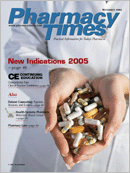Publication
Article
Pharmacy Times
Avoiding Flu Vaccine Shortages for Hospital Staff
Periodic shortages in drug supplies plague all pharmacistsand, if I do say so, pharmacists perform anadmirable job of implementing strategies to copewith these shortages while optimizing patient outcomes. Itoften requires extra work formany pharmacists and theirstaffs, but their efforts areaccomplished collaborativelywith medical staff membersand remain transparent topatients.
On the other hand, the fluvaccine shortage of 2004 was avery public phenomenon. Itwas worsened by media hype,which created fear and limitedavailability of the vaccine tohigh-risk groups.
Last year, my hospital appointedan advisory groupcomposed of pharmacists, infectiousdisease physicians,and representatives from epidemiology,infection control,and hospital administrationdepartments, to develop and implement a program to controlvaccine distribution. The purpose was to prioritizeimmunization based on scientific data and guidelinesimposed by federal and state agencies.
In retrospect, I can say that this approach was appropriate,but it was not efficient or convenient and probably wasnot effective. The hospital decided to give patients the highestpriority and severely restricted immunizations to directpatient caregivers. Whereas decentralized clinical pharmacistsand retail pharmacists were included in the high-prioritygroup, technicians, central-pharmacy-based staff, andothers without direct patient contact were placed at a muchlower priority level.
By the time the last shipment arrived, the hype had abated,the incidence of infected patients was only average, andpatients (including health care workers) who had beendenied vaccinations earlier apparently decided to forgoimmunization. At the end of the flu season, the hospital hadthousands of unused doses ofvaccine in its inventory.
This year, the hospital hastaken a different approachwhile complying with recommendationsfrom the Centersfor Disease Control andPrevention and the AdvisoryCommittee on ImmunizationPractices. All health care workerswill be eligible for vaccine asa top priority, along with highriskpatients, on a "first-come,first-served" basis. We areencouraging most health careworkers (except those who carefor severely immunocompromisedpatients) to considerusing the nasal form of the vaccine.We are attempting to educatehospital staff membersabout making informed decisions regarding immunization.
I suspect that most hospitals and their pharmacies developsimilar strategies. Yet, do they make sure that the entirestaff understands the strategies and goals? Are they proactivein working with the media to dispel myths, allay fears,and encourage optimal utilization? Do they effectively partnerwith nearby hospitals and community pharmacy colleaguesto optimize patient outcomes? I wonder.
Mr. McAllister is director of pharmacy at University of NorthCarolina (UNC) Hospitals and Clinics and associate dean forclinical affairs at UNC School of Pharmacy, Chapel Hill.







